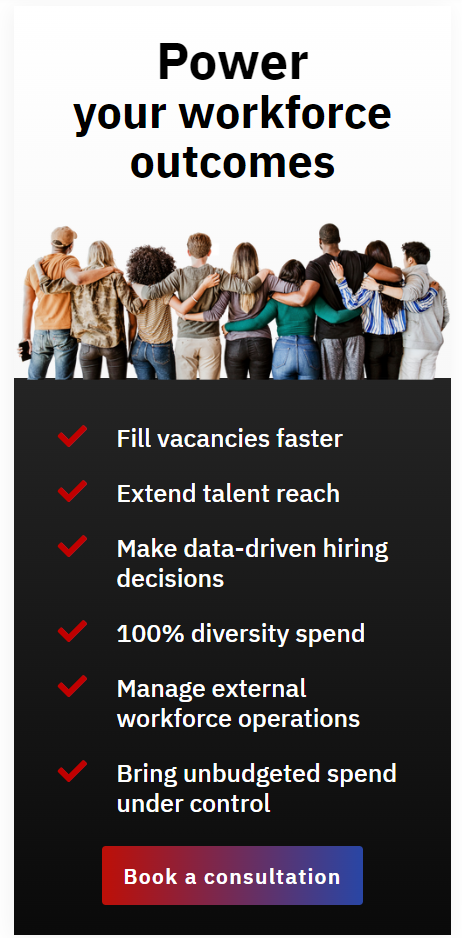Published : April 23rd 2025
Why Building the Right MSP Business Case Is Essential for Growth
A Managed Service Provider (MSP) can be a game-changer when it comes to handling contingent workforce management, consolidating vendor oversight, and boosting efficiency. Yet, to figure out if an MSP truly makes sense for your business, you need a solid MSP business case—one that goes beyond guesswork. That involves real numbers, clear goals, and a realistic look at potential gains.
In this article, we’ll break down how to assess your current costs, weigh the benefits, and pinpoint the kind of managed services ROI you can expect. Along the way, we’ll address common reservations, like budget constraints and implementation concerns, and show you how to frame each point in practical, measurable terms. This will give you a well-grounded plan for deciding whether an MSP is the right move for your organization.
Why Build a Business Case for an MSP
Following the idea of centralizing your contingent workforce management, it’s worth considering the everyday hurdles that arise from decentralized or ad hoc staffing solutions. Lack of visibility, inconsistent vendor rates, and compliance headaches all point to why many organizations move toward a Managed Service Provider in the first place.
According to a recent study, Global IT managed services revenue is set to reach $595 billion in 2025, growing 13% year-over-year with 341,000 partners delivering services and with 15% growth in APAC.
Yet switching to an MSP doesn’t happen in a vacuum—senior leaders typically need to see clear, measurable outcomes. A well-defined MSP business case highlights potential savings, mitigates worries about risk, and shows how this new approach supports broader goals, like better resource allocation or strategic hiring. In short, it ensures everyone sees the value, making for a smoother transition once you decide to partner with an MSP.
1. Identifying Key Drivers for an MSP
Many organizations see cost efficiency as the top reason for considering an MSP. Standardized vendor rates, reduced administrative burdens, and potential bulk discounts can all significantly lower labor spend. For first-timers, these improvements can be a huge draw, especially if the current setup is chaotic or inconsistent.
Risk and compliance also rank highly. Centralizing oversight of legal, tax, and worker classification issues lowers the odds of costly missteps. Meanwhile, better access to talent can speed up time-to-fill and boost hiring quality, crucial for specialized roles where every day counts. If your company wants to expand its talent reach, that alone can justify building a MSP business case to support a more robust approach.
2. Cost Analysis
Start by looking at your current spending patterns, like vendor fees, extended time-to-fill, or overtime costs, and line them up against what you’d likely pay under an MSP. This is the essence of MSP cost analysis, to gather data on everything from the number of agencies you manage to hidden rush charges. A consolidated approach can reveal real savings you might otherwise miss.
Be aware that some MSPs charge setup or technology integration fees. While these may impact your initial budget, the longer-term efficiencies usually offset them once processes stabilize. Use realistic projections rather than overly optimistic ones. A simple cost model can help you calculate annual savings, break-even points, and potential managed services ROI. This transparent view of finances strengthens your MSP business case and helps leadership see the program’s worth.
3. Benefits Projections
Looking at tangible gains, an MSP can unify vendor billing, maintain consistent markups, and often reduce fill times by 10% to 25%, depending on the starting baseline. This standardization can help clean up billing headaches and improve cash flow, which speaks directly to leadership priorities around efficiency.
On the intangible side, less stress on your internal teams and a stronger brand reputation can be meaningful advantages. If fewer errors or delays translate to happier employees and clients, that’s a big win. As for timelines, you might see baseline returns in six to twelve months, though advanced add-ons, like direct sourcing, could extend the window. The key is to match the scale of MSP service offerings to your ambitions, ensuring you reap benefits at a manageable pace.
4. Potential Risks & Mitigations
One worry is over-reliance on a single provider. If the MSP stumbles, you don’t want your entire workforce strategy to collapse. Contract clauses that allow alternative suppliers or renegotiation can help balance this. A well-outlined SLA also keeps performance expectations transparent.
Cultural pushback is another hurdle. Staff or departments might not welcome a shift to MSP-run operations, especially if they’re used to doing things in-house. Clear communication and early involvement can reduce friction, letting people adapt before major changes happen.
Finally, don’t forget the risk of rushing. Underestimating setup time can lead to confusion. Consider a pilot or phased approach as part of your MSP adoption strategy, giving everyone time to adjust and ensuring your MSP business case remains on target.
5. Gaining Executive Buy-In
Leadership often prioritizes cost savings, compliance, and strategic growth, so linking your MSP business case to these objectives is crucial. Presenting tangible data, like MSP cost analysis or ROI estimates, makes your argument more compelling. If executives see straightforward numbers that prove managed services ROI, they’re more likely to give the green light.
SIA estimates that the global workforce solutions ecosystem was valued at approximately $2.3 trillion in 2023, reflecting the increasing reliance on outsourced talent solutions such as MSPs.
It also pays to gather internal champions early. When department heads see clear advantages, they can help spread positive sentiment across the organization. Plus, a well-structured proposal detailing cost, timeline, and risk sets leadership at ease. Consistent follow-up further demonstrates commitment, making it clear you’re serious about seeing the MSP initiative through to success.
Workspend’s Approach
Workspend prioritizes both cost efficiency and quality, aiming to reduce vendor markups and overhead through vendor consolidation, real-time analytics, and rate benchmarking. By presenting a clear MSP business case with proven cost-saving strategies, Workspend helps companies see the financial upside of an MSP partnership. But it’s not just about cost. We also focus on avoiding compliance pitfalls, thanks to robust processes for worker classification and legal oversight.
Beyond the numbers, we believe in a collaborative model that evolves with your contingent workforce management needs. As those requirements shift over time, we adapt, offering advanced analytics, direct sourcing options, or other specialized services. It’s the kind of flexible MSP adoption strategy that resonates with organizations seeking both operational efficiency and a future-ready workforce.
Conclusion
Putting together a detailed MSP business case, covering cost analysis, projected benefits, and a plan to address risks, lays the groundwork for a successful MSP launch. By quantifying potential wins and transparently addressing concerns, you give your organization a clear path forward with less guesswork and fewer surprises.
Take a close look at your current staffing model, note any inefficiencies, and think about how an MSP could smooth them out. If you’re ready to build a program that’s tailored to your unique challenges, an experienced provider can guide you.
Remember, an MSP’s true power isn’t just about saving money, it’s about creating a more efficient, adaptable approach to contingent workforce management that aligns with your long-term vision.
Ready to build your MSP business plan? Contact Workspend today for a free discovery assessment, and let’s map out a program that meets your organization’s unique needs for cost efficiency, compliance, and managed services ROI.
You may also like:
5 MSP Performance Metrics You Should Track to Ensure Success
Published : March 14th 20255 MSP Performance Metrics You Should Track to Ensure Success Managed Service Providers (MSPs) take on essential tasks—from IT support to network monitoring and infrastructure management—so clients can concentrate on their core objectives...
AI Should Augment Human Intelligence, Not Replace It
Will smart machines replace human workers? How human intelligence can work with artificial intelligence to produce augmented intelligence.
Common Challenges When Setting Up an MSP and How to Overcome Them
Published : March 4th 2025Common Challenges When Setting Up an MSP and How to Overcome Them Finding the right balance of full-time employees and temporary staff is a key strategic goal for many organizations facing rising demands and growing compliance pressures. As...
Power your workforce
outcomes with a diversity MSP






